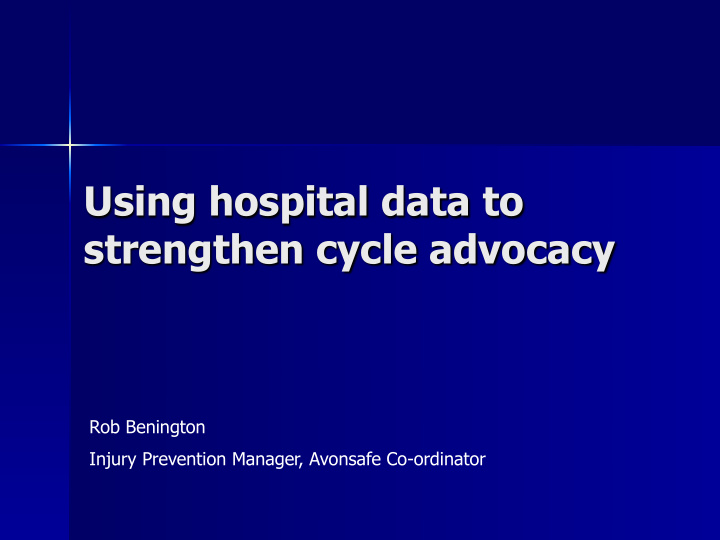



Using hospital data to strengthen cycle advocacy Rob Benington Injury Prevention Manager, Avonsafe Co-ordinator
http://www.theguardian.com/ environment/bike-blog/2013/jan/16/ cycling-parliamentary-inquiry-evidence http://travel.cnn.com/sydney/play/ cyclists-revolution-bike-paths-cover- sydney-509438
Public Health Outcomes n Excess weight 4-5 and 10-11 year olds n Excess weight in adults n Proportion of physically active and inactive adults n Childhood emergency admissions due to injury n Road Safety (KSI) n Utilisation of outdoor space for exercise / health n Mortality due to air pollution, causes considered preventable, cancer, and CVD n Carbon management Balance?
An integrated approach
What encourages cycling? Improved infrastructure n Confidence ( Training, road danger reduction ) n Confidence ( Fewer incidents and injuries) n Cycle friendly employers n Relevant image n
What ’ s stopping us cycling? n Perception of risk and hazard – Traffic speeds – Reported and previous injuries n Lack of convenience – Severance and lack of permeability – Poor or undesirable infrastructure n Lack of confidence – Physical ability – Image of cyclists and cycling
hazard Injuries (risk) = x exposure
People Hours Injury Burden x Aggregate Hazard = (Exposure) (Emergency admissions) n (
“ A total of 3,192 people were killed or seriously injured on UK roads while riding a bicycle last year ” . The Times, 5-11-12 A total of 17,653 English cyclists were admitted to hospital with an injury during 2011-12. www.hesonline.nhs.uk c. 13% of all attendances at emergency departments are admitted. Ormel, 1999 c. 135,700 cyclists from England and c. 160,000 from the UK were admitted to hospital or treated in an emergency department during 2011-12. NHS Bristol, 2012
Cyclist injuries resulting in admission (England) 2011-12 Collision: Pedestrian / animal 117 Collision: Other cyclist 396 Collision: 2-3 wheeled motor vehicle 76 Collision: Car, pick up truck or van 2,450 Collision: Heavy transport vehicle or bus 180 Collision: Railway train or railway vehicle 2 Collision: Other non-motor vehicle 24 Collision: Fixed and stationary object 681 Non-collision incident 12,301 Other and unspecified 1,426 Total Cyclists 17,653 (Total car occupants) 14,573
Travel and transport injuries Numbers of injuries requiring hospital admission by mode of transport (2011-12) 17653 17000 16000 14573 15000 14000 13000 12000 9976 11000 9633 Number of 10000 9000 admissions 8000 6723 Non-collision injuries 7000 6000 4142 5000 4000 3000 2000 1000 0 Animal Cyclists occupants Motorcycle Pedestrians Others riders riders Car Transport type
What causes non- collisions Slippery road surfaces Poor road surface Kerbs and rail lines Cyclist related causes “ An introduction to non-collision cycling incidents ” . NHS Bristol, 2012. www.tinyurl.com\avonsafecycling
What we don ’ t know What works? What makes some children more likely to sustain NCIs
Summary n Injury (and hazard) discourages people from cycling n Managing hazard will facilitate cycling n Most cycling injuries are caused by non-collision incidents
What might reduce the hazard of NCI ’ s? n Improved infrastructure n Training n Fewer incidents and injuries n Cycle friendly employers n Improved image (= more cycling = better cyclists)
1. Infrastructure
2. Training n Safe riding strategy (Explicit consideration of alternative mode of travel if weather conditions, personal health or bike maintenance require it). Spot Hazards – List of significant hazards could be included in L2 n How to traverse kerbs and rail lines (While mentioned in L3 an observed demonstration should be required) n Uneven road surfaces (L3; Speed can be good) n + Others? Blue Light runs, RRAGAR
It is optimal to pursue public health priorities through an integrated approach. Addressing non-collision cycling hazards will help make cycling a more attractive travel option. Research is at an embryonic stage.
www.tinyurl.com\avonsafecycling Robert.benington@bristol.gov.uk
Recommend
More recommend